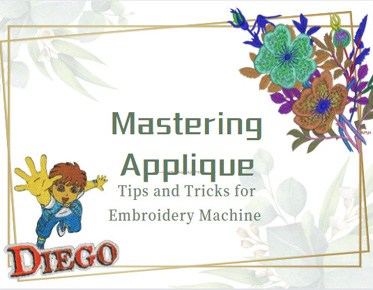Mastering Applique: Tips and Tricks for Embroidery Machine Enthusiasts
Embroidery enthusiasts are often captivated by the intricate art of applique. In this guide, we'll delve into the world of applique embroidery, offering a comprehensive overview of techniques and strategies to help you master this versatile and creative form of stitching.
● What is Applique in
Embroidery
● Machine Settings
and Stitch Selection
● Applique Stitching
Techniques
● Embellishments
and Finishing Touches
Applique digitizing is a decorative technique in embroidery where pieces of fabric are sewn onto a base fabric to create patterns, motifs, or designs. This technique adds dimension, texture, and visual interest to the embroidered piece, making it a popular choice among crafters and artists alike.
Considerations
for Fabric Selection
Selecting the right fabric for your applique project is crucial for achieving the desired result. Consider factors such as the weight, texture, and stretch of the fabric, as well as its compatibility with your design and embroidery machine. Fabrics with a tight weave, such as cotton or linen, work well for applique due to their stability and ease of stitching.
Types
of Fabrics Suitable for Applique
There is a wide range of fabrics suitable for applique, each offering unique qualities and characteristics. From traditional cotton and linens to luxurious silks and satins, the choice of fabric can significantly impact the look and feel of your applique design. Experiment with different fabric types to discover which ones best suit your style and project requirements.
Selecting
or Creating a Design
Before you begin stitching, spend some time selecting or creating a design for your applique project. Consider the theme, size, and complexity of the design, as well as its suitability for applique. You can choose from pre-made patterns, create your designs, or modify existing ones to suit your preferences.
Sizing
and Scaling
Once you have chosen a design, it's essential to size and scale it to fit your embroidery hoop or desired project dimensions. Use design software or templates to adjust the size of the design while maintaining its proportions and clarity. This step ensures that your applique pieces will fit seamlessly within the overall composition of your embroidery project.
Importance
of Stabilization
Stabilizing your fabric is essential for achieving clean, precise stitches in applique embroidery. Stabilizers provide support and structure to the fabric, preventing stretching, puckering, or distortion during stitching. Proper stabilization ensures that your applique pieces will lay flat and adhere smoothly to the base fabric.
Types
of Stabilizers and Their Uses
There are various types of stabilizers available, each designed for specific applications and fabric types. Tear-away stabilizers are suitable for lightweight fabrics and designs with minimal stitch density, while cut-away stabilizers provide more substantial support for heavier fabrics and intricate designs. Water-soluble stabilizers are ideal for delicate fabrics and designs that require temporary support during stitching.
Proper
Hooping for Applique
Hooping your fabric correctly is essential for achieving even tension and stitch quality in applique embroidery. Ensure that the fabric is taut and smooth within the hoop, with no wrinkles or puckers. Use hoop grids or templates to guide the placement and alignment of your applique pieces, ensuring accuracy and precision in your stitching.
Tips
for Achieving Tautness Without Stretching the Fabric
To achieve tautness without stretching the fabric, gently tug on the edges of the fabric while hooping, taking care not to distort or stretch it excessively. Use clips or clamps to secure the fabric in place, ensuring that it remains taut throughout the stitching process. Experiment with different hooping techniques to find the method that works best for your fabric and project requirements.
Needle
Types for Applique
Choosing the right needle is essential for achieving clean, precise stitches in applique embroidery. Use sharp or embroidery needles, which have a fine point and a large eye, to penetrate the fabric cleanly without causing damage. Needle size should be appropriate for the weight and thickness of the fabric, ensuring smooth stitching and minimal tension on the thread.
Choosing
the Right Thread
Selecting the right thread is equally important for achieving high-quality results in applique embroidery. Use high-quality embroidery thread that is strong, smooth, and colorfast, with a sheen that complements your fabric and design. Match the thread color to the fabric color for seamless blending, or choose a contrasting color for added visual interest and emphasis.
Adjusting
Tension
Proper tension adjustment is critical for achieving balanced, even stitches in applique embroidery. Test your machine's tension settings on scrap fabric before beginning your project, making adjustments as needed to achieve optimal stitch quality. Be mindful of thread type, needle size, and fabric thickness, as these factors can affect tension and stitch appearance.
Choosing
the Appropriate Stitch
Selecting the right stitch is essential for achieving the desired effect in applique embroidery. Experiment with different stitch options, such as satin stitch, blanket stitch, or zigzag stitch, to find the one that best suits your design and fabric type. Consider factors such as stitch length, width, and density, as well as the overall aesthetic of your project.
Marking
Guidelines
Accurate placement is crucial for achieving precise results in applique embroidery. Use marking guidelines such as chalk, water-soluble markers, or tailor's chalk to outline the placement of your applique pieces on the base fabric. Take care to position the pieces evenly and symmetrically, ensuring a balanced and harmonious composition.
Techniques
for Precise Placement
Experiment with different techniques for securing and positioning your applique pieces before stitching. Pinning or basting can help hold the pieces in place temporarily, allowing you to adjust their placement as needed. Take your time to align the edges and corners of the pieces accurately, ensuring a seamless transition between applique and base fabric.
Satin
Stitch
The satin stitch is a classic choice for outlining and filling applique designs, offering a smooth, polished finish. Experiment with stitch length and density to achieve the desired coverage and texture in your embroidery. Use a matching or contrasting thread color to enhance the visual impact of your applique stitches.
Blanket
Stitch
The blanket stitch is commonly used for securing applique pieces to the base fabric, providing a decorative edge and added reinforcement. Experiment with stitch length, width, and spacing to create different effects and textures in your embroidery. Use a matching or contrasting thread color to highlight the edge of your applique pieces.
Zigzag
Stitch
The zigzag stitch is versatile and well-suited for securing applique pieces to the base fabric, as well as for filling in larger areas of color or texture. Experiment with stitch width, length, and density to achieve different effects and styles in your embroidery. Use a matching or contrasting thread color to enhance the visual impact of your zigzag stitches.
Trimming
Excess Fabric
Once stitching is complete, carefully trim any excess fabric from around the edges of your applique pieces to create clean, defined shapes. Use sharp scissors or applique scissors to trim close to the stitching line, taking care not to cut into the stitches or fabric. Remove any stray threads or fibers to ensure a neat and professional finish.
Removing
Stabilizer
After trimming, remove any stabilizer from the back of your embroidery project to reveal the finished design. Follow the manufacturer's instructions for removing tear-away or water-soluble stabilizers, taking care not to damage the fabric or stitches. Gently press the embroidery on the wrong side with a pressing cloth to smooth out any wrinkles or creases.
Adding
Embroidery Details
Enhance your applique embroidery with additional embellishments and details, such as embroidery stitches, beads, or sequins. Experiment with different embroidery techniques, such as French knots, seed stitches, or chain stitches, to add texture and dimension to your designs. Use a matching or contrasting thread color to complement the overall color scheme of your embroidery.
Incorporating
Beads or Sequins
For a touch of sparkle and shine, consider adding beads or sequins to your applique embroidery. Use a beading needle and specialty thread to secure the beads or sequins to the fabric, creating intricate patterns or designs. Experiment with different bead sizes, shapes, and colors to achieve the desired effect, adding depth and visual interest to your embroidery.
Mastering the art of applique embroidery requires patience, practice, and a willingness to experiment
with different techniques and materials. By following the tips and tricks
outlined in this guide, you can elevate your embroidery projects to new levels
of creativity and craftsmanship. Whether you're a novice or an experienced
embroiderer, the possibilities for applique are endless, allowing you to create
unique and personalized designs that showcase your skills and style. So grab
your embroidery machine, select your fabrics and threads, and start stitching
your way to applique mastery!



